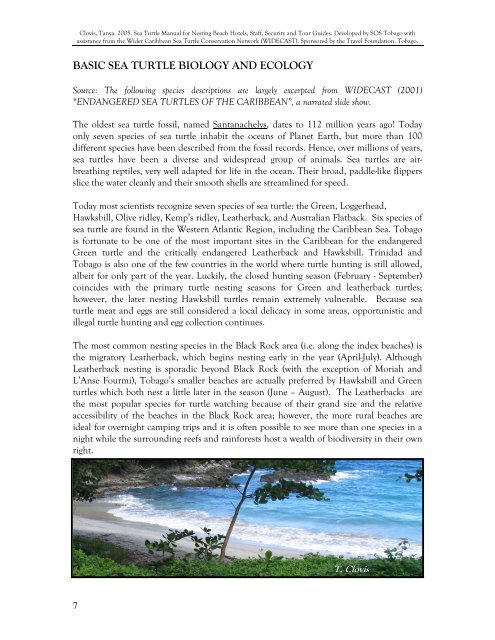Clovis, Tanya. - WIDECAST
Clovis, Tanya. - WIDECAST
Clovis, Tanya. - WIDECAST
Create successful ePaper yourself
Turn your PDF publications into a flip-book with our unique Google optimized e-Paper software.
<strong>Clovis</strong>, <strong>Tanya</strong>. 2005. Sea Turtle Manual for Nesting Beach Hotels, Staff, Security and Tour Guides. Developed by SOS Tobago with<br />
assistance from the Wider Caribbean Sea Turtle Conservation Network (<strong>WIDECAST</strong>). Sponsored by the Travel Foundation. Tobago.<br />
BASIC SEA TURTLE BIOLOGY AND ECOLOGY<br />
Source: The following species descriptions are largely excerpted from <strong>WIDECAST</strong> (2001)<br />
“ENDANGERED SEA TURTLES OF THE CARIBBEAN”, a narrated slide show.<br />
The oldest sea turtle fossil, named Santanachelys, dates to 112 million years ago! Today<br />
only seven species of sea turtle inhabit the oceans of Planet Earth, but more than 100<br />
different species have been described from the fossil records. Hence, over millions of years,<br />
sea turtles have been a diverse and widespread group of animals. Sea turtles are airbreathing<br />
reptiles, very well adapted for life in the ocean. Their broad, paddle-like flippers<br />
slice the water cleanly and their smooth shells are streamlined for speed.<br />
Today most scientists recognize seven species of sea turtle: the Green, Loggerhead,<br />
Hawksbill, Olive ridley, Kemp’s ridley, Leatherback, and Australian Flatback. Six species of<br />
sea turtle are found in the Western Atlantic Region, including the Caribbean Sea. Tobago<br />
is fortunate to be one of the most important sites in the Caribbean for the endangered<br />
Green turtle and the critically endangered Leatherback and Hawksbill. Trinidad and<br />
Tobago is also one of the few countries in the world where turtle hunting is still allowed,<br />
albeit for only part of the year. Luckily, the closed hunting season (February - September)<br />
coincides with the primary turtle nesting seasons for Green and leatherback turtles;<br />
however, the later nesting Hawksbill turtles remain extremely vulnerable. Because sea<br />
turtle meat and eggs are still considered a local delicacy in some areas, opportunistic and<br />
illegal turtle hunting and egg collection continues.<br />
The most common nesting species in the Black Rock area (i.e. along the index beaches) is<br />
the migratory Leatherback, which begins nesting early in the year (April-July). Although<br />
Leatherback nesting is sporadic beyond Black Rock (with the exception of Moriah and<br />
L’Anse Fourmi), Tobago’s smaller beaches are actually preferred by Hawksbill and Green<br />
turtles which both nest a little later in the season (June – August). The Leatherbacks are<br />
the most popular species for turtle watching because of their grand size and the relative<br />
accessibility of the beaches in the Black Rock area; however, the more rural beaches are<br />
ideal for overnight camping trips and it is often possible to see more than one species in a<br />
night while the surrounding reefs and rainforests host a wealth of biodiversity in their own<br />
right.<br />
T. <strong>Clovis</strong><br />
7
















